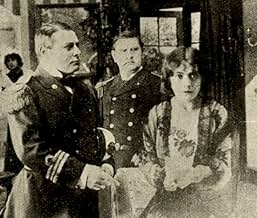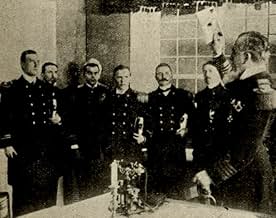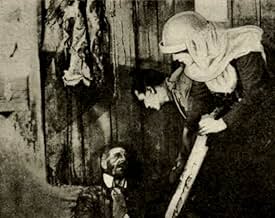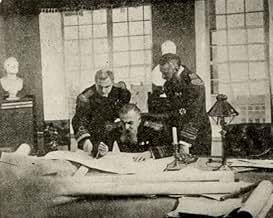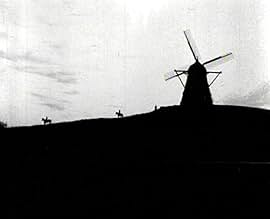अपनी भाषा में प्लॉट जोड़ेंOn the brink of war, Lt. van Hauen is summoned to take command of the cruiser, but due to unforeseen events, he is wrongfully convicted as a traitor.On the brink of war, Lt. van Hauen is summoned to take command of the cruiser, but due to unforeseen events, he is wrongfully convicted as a traitor.On the brink of war, Lt. van Hauen is summoned to take command of the cruiser, but due to unforeseen events, he is wrongfully convicted as a traitor.
- निर्देशक
- लेखक
- स्टार
फ़ीचर्ड समीक्षाएं
When you look well into the past of cinema, what you usually get are historically significant films, and that isn't absolutely a synonym for good films. Well here's one you may want to watch simply for the fact that it is good.
Sealed orders is Christiansen's first film (a man I only know for the film "Haxan")and it is war drama at it's best. Tragic twist of fate, clear storyline, good pacing and great lighting work. It's a few years in advance on it's time, but it isn't technical wonders of the cinema of the 20s or of now. It's still theatrical, though it isn't anything like the early films of it's time and before. The film survived to our days in a great condition, nothing like the jerky pictures moving at a wrong speed we like to think of.
To put it simply, you'll watch it and have a great time, as long you like dramas of this kind. But if you actually cared enough to read a IMDb review of a 1914 film, It's surely your kind.
Sealed orders is Christiansen's first film (a man I only know for the film "Haxan")and it is war drama at it's best. Tragic twist of fate, clear storyline, good pacing and great lighting work. It's a few years in advance on it's time, but it isn't technical wonders of the cinema of the 20s or of now. It's still theatrical, though it isn't anything like the early films of it's time and before. The film survived to our days in a great condition, nothing like the jerky pictures moving at a wrong speed we like to think of.
To put it simply, you'll watch it and have a great time, as long you like dramas of this kind. But if you actually cared enough to read a IMDb review of a 1914 film, It's surely your kind.
10poulbro
A wonderful silent film! This is one of the most innovative silent films ever. The danish director Benjamin Christensen made his director debut with this film that he financed himself. With his own company Dansk Biografkompagni, he started filming this film, that he wrote over one night. The plot in the film is good but not great. What makes this film so interesting is how Benjamin Christensen used darkness vs. light to create an atmosphere. Before this film a lack of light was considered as a lack of talent, but Benjamin proved that shadows can be very effective.
A great film
A great film
"Det Hemmelighedsfulde X" ( The Mysterious X or Sealed Orders ) was the first film from the Danish director Herr Benjamin Christensen, a film director with a very strange inclination toward occult sciences, witchcraft, macabre rituals and other black celebrations, his film "Häxan" (1922) ( wherein Herr Christensen appeared as Herr Satan himself ) being the paradigm of these strange Danish tastes. In every film of his film career ( in Denmark, Germany or the USA ), besides the liking for Herr Devil and Mr. Evil, there is always, more or less, depicted a strange sense of the futility of life, the darkness of men's souls, and no much place for happy endings.
Det Hemmelighedsfulde X" is the story of Lieutenant Van Hauen ( Herr Christensen himself ), a man very concerned to perform his duty, that is to say, make war while his wife makes love with Count Spinelli, a sinister Count with many obscure intentions ( this reminds this Herr Graf of something. ); intrigues about secret sealed war orders given to Herr Van Hauen that are revealed to the enemy will put the lieutenant's honor in question and his physical integrity at stake in a film very well paced and directed, a mixture of spy film ( those wicked people use modern communication systems this German Count is very fond of, such as carrier pigeons and Morse code ), war film ( mysterious landscapes, sinister mills, and battles on land and sea are seen in connection with the plot ), and suspense film ( the efforts of the lieutenant's family to prove his innocence at the end of the film are very well resolved, giving a sense of modernity for a film made in 1914 ).
"Det Hemmelighedsfulde X" is an excellent debut; Christensen's characteristics I've mentioned before are not found in this film; in their stead are conventional human weaknesses such as adultery, treachery and honor, although there are some shots depicting the dark intentions the Danish director was so fond of, as when Count Spinelli is trapped in the mill's cellar threatened by rats .
And now, if you'll allow me, I must temporarily take my leave because this German Count must do the honors of the Schlöss in this Count's honor.
Det Hemmelighedsfulde X" is the story of Lieutenant Van Hauen ( Herr Christensen himself ), a man very concerned to perform his duty, that is to say, make war while his wife makes love with Count Spinelli, a sinister Count with many obscure intentions ( this reminds this Herr Graf of something. ); intrigues about secret sealed war orders given to Herr Van Hauen that are revealed to the enemy will put the lieutenant's honor in question and his physical integrity at stake in a film very well paced and directed, a mixture of spy film ( those wicked people use modern communication systems this German Count is very fond of, such as carrier pigeons and Morse code ), war film ( mysterious landscapes, sinister mills, and battles on land and sea are seen in connection with the plot ), and suspense film ( the efforts of the lieutenant's family to prove his innocence at the end of the film are very well resolved, giving a sense of modernity for a film made in 1914 ).
"Det Hemmelighedsfulde X" is an excellent debut; Christensen's characteristics I've mentioned before are not found in this film; in their stead are conventional human weaknesses such as adultery, treachery and honor, although there are some shots depicting the dark intentions the Danish director was so fond of, as when Count Spinelli is trapped in the mill's cellar threatened by rats .
And now, if you'll allow me, I must temporarily take my leave because this German Count must do the honors of the Schlöss in this Count's honor.
This looks like a first film, and, of course, it's the directorial début of Benjamin Christensen, whose place in film history rests mostly upon "Häxan" ("Witchcraft Through the Ages"), his third motion picture. This one does not have a distinctive style, not as "Häxan" or "Blind Justice" (Hævnens nat), his second picture, would. Yet, this is common; most filmmakers begin not with their own designs and ideas, but rather copy (to greater extent than usual and to less effect) from those who came before them. What Christensen copies, then, is where this shows promise.
At this time, in the early 1910s before "The Birth of a Nation", Danish cinema was perhaps the best in the world, so Christensen had much to work with. From what I've seen, mise-en-scène was especially developed. From a historical perspective, the lighting effects in Danish cinema were remarkable, influencing Weimar cinema and, thus, American film noir. There are such examples here. None of it seems especially original, but represents the best that others had previously used: low-key lighting for dramatic effect, stunning silhouettes and diegetic, or seemingly diegetic, lighting. Some scenes are only lit by the sunlight coming through a widow or door, or from a flashlight. Others seem as though they're lit by diegetic sources, such as a lamp or from turning on a light switch. Generally, this was done by stopping filming after a character flipped a switch, then the lighting scheme for the scene was setup and filming resumed, to later be touched up by editing. Objects often partially hide the characters, and the original darkness also helps to cover this effect, but if you look closely, you can sometimes notice the cut.
Furthermore, mirrors figure prominently in some scenes, as they do elsewhere in Danish pictures. Early on, Danish filmmakers weren't too concerned with narratives, but by the time of this one, they were becoming more complex. "Häxan" is something of a pinnacle. "Sealed Orders", or "Orders Under Seal", "The Mysterious X" (Det Hemmelighedsfulde X)--whatever you want to call this film--has a more-traditionally-engaging story. It takes from the sensational genre, a uniquely Scandinavian type of picture, with the cheating wife, scandals, being trapped in a cellar and the convoluted suspense. It was sold as such (see the tagline), but it's also simply a melodrama. The last-minute rescue might even owe something to the American director D.W. Griffith.
This isn't entirely promising stuff to work with, but it's a fine beginning, and Christensen would go on to demonstrate his skill. "Sealed Orders" contains plenty of errors: jump cuts, theatrical long shots and the obvious daytime photography near the end for what's supposed to be nighttime in the story. Perhaps the tinting or something was lost for the print I saw, but Griffith and Bitzer rectified this problem in "The Birth of a Nation" by filming at night, and Christensen would do the same for "Häxan". Still, this is a promising début.
At this time, in the early 1910s before "The Birth of a Nation", Danish cinema was perhaps the best in the world, so Christensen had much to work with. From what I've seen, mise-en-scène was especially developed. From a historical perspective, the lighting effects in Danish cinema were remarkable, influencing Weimar cinema and, thus, American film noir. There are such examples here. None of it seems especially original, but represents the best that others had previously used: low-key lighting for dramatic effect, stunning silhouettes and diegetic, or seemingly diegetic, lighting. Some scenes are only lit by the sunlight coming through a widow or door, or from a flashlight. Others seem as though they're lit by diegetic sources, such as a lamp or from turning on a light switch. Generally, this was done by stopping filming after a character flipped a switch, then the lighting scheme for the scene was setup and filming resumed, to later be touched up by editing. Objects often partially hide the characters, and the original darkness also helps to cover this effect, but if you look closely, you can sometimes notice the cut.
Furthermore, mirrors figure prominently in some scenes, as they do elsewhere in Danish pictures. Early on, Danish filmmakers weren't too concerned with narratives, but by the time of this one, they were becoming more complex. "Häxan" is something of a pinnacle. "Sealed Orders", or "Orders Under Seal", "The Mysterious X" (Det Hemmelighedsfulde X)--whatever you want to call this film--has a more-traditionally-engaging story. It takes from the sensational genre, a uniquely Scandinavian type of picture, with the cheating wife, scandals, being trapped in a cellar and the convoluted suspense. It was sold as such (see the tagline), but it's also simply a melodrama. The last-minute rescue might even owe something to the American director D.W. Griffith.
This isn't entirely promising stuff to work with, but it's a fine beginning, and Christensen would go on to demonstrate his skill. "Sealed Orders" contains plenty of errors: jump cuts, theatrical long shots and the obvious daytime photography near the end for what's supposed to be nighttime in the story. Perhaps the tinting or something was lost for the print I saw, but Griffith and Bitzer rectified this problem in "The Birth of a Nation" by filming at night, and Christensen would do the same for "Häxan". Still, this is a promising début.
A tale of injustice and redemption at the onset of the First World War. Fascinating glimpse into the distant past.
क्या आपको पता है
- ट्रिवियाShot over the course of three months.
- इसके अलावा अन्य वर्जनFor the film's release in Germany, all references to spies were eliminated, as any references to spies were expressly forbidden by the government censors. The spies in the film were turned, via the intertitles, into smugglers.
- कनेक्शनEdited into Eventyret om dansk film 3: Danske filmstjerner og kometer - 1913-1923 (1996)
टॉप पसंद
रेटिंग देने के लिए साइन-इन करें और वैयक्तिकृत सुझावों के लिए वॉचलिस्ट करें
विवरण
- चलने की अवधि1 घंटा 24 मिनट
- रंग
- ध्वनि मिश्रण
- पक्ष अनुपात
- 1.33 : 1
इस पेज में योगदान दें
किसी बदलाव का सुझाव दें या अनुपलब्ध कॉन्टेंट जोड़ें

टॉप गैप
By what name was Det hemmelighedsfulde X (1914) officially released in Canada in English?
जवाब
